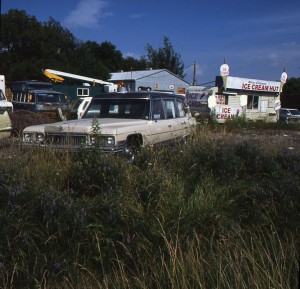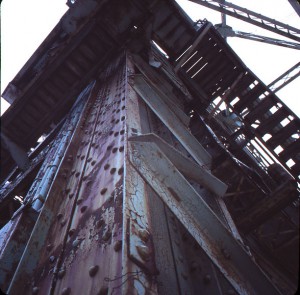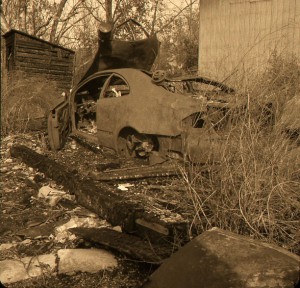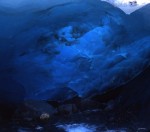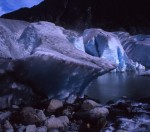Who doesn’t like ice cream, and who doesn’t like funeral cars? This shot has both! Shot with a TL-120-55 on RDP III.
Tag Archives: wide
Riveted
My friend Rick was shooting a bridge near Cherry Street in Toronto and invited me down. Apparently a road crew was about to refurbish the bridge, so we thought we better capture the peeling paint while we had a chance. Shot with TL-120 modified with Sam Smith’s 55mm conversion Mamiya lenses on Fuji film.
Final Rusting Place
Approximately once a year dr5 offers “Dev2” service, which is basically sepia processing. The only Fuji film that can be processed in dr5 is Neopan 400, and at that only in Dev2. When dr5 announced the limited availability of Dev2 last year, I grabbed the only roll of Neopan 400 I had, and drove out to the airport. Behind a strip mall row, beside a dilapidated parts factory, resided a trio of desecrated automobile shells. This was part of that day’s one roll shoot. Shot with a TL-120 modified with Sam Smith’s 55mm conversion, on the aforementioned film using a handheld meter.
Not Too Close / Plowing Prow
The winter ice has been terrible at the Mendenhall Glacier this year. The combination of snow, rain, and avalanches has meant I haven’t ventured near it, much less tried to cross it to get new winter images of the glacier. These two views from 2008 (captured with my TL120-55) will have to suffice. The area of ice pictured here is now long gone. In the summer it is open water. In the winter, it is lake ice.
Not Too Close
This image is taken about a mile and quarter across the lake from where I laced on my skates. Because of the current lake level, 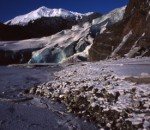 there is a patch of stable, rocky beach here. Because of cliff and creeks, it isn’t possible to walk around the lake to get to this bit of beach. Crossing the lake is the only way. Everything off that bit of beach is in flux and subject to change at any moment.
there is a patch of stable, rocky beach here. Because of cliff and creeks, it isn’t possible to walk around the lake to get to this bit of beach. Crossing the lake is the only way. Everything off that bit of beach is in flux and subject to change at any moment.
The cracks parallel to the shore show that the lake ice has sunk, and may again. The white froth beside the green glacier is a flowing and frozen waterfall. There is another stream coming down closer to the camera. Both are flowing under the ice, taking relative warmth, and creating areas of thinner lake ice. The glacier is calving from above and below, even in winter. Because of all this, approaching the glacier is a dance with an uncertain beast. I hunt for images and capture them as I approach, never certain when I’ll decide I’ve gone close enough and its time to retreat.
This image was made early in the morning’s dance. The colors and textures beckoned me closer despite the poor ice conditions.
Plowing Prow
Closer (and farther to the left) than the previous one, I captured this image. My exploration is stymied. The lake ice has been broken and refrozen several times, 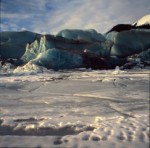 and there is water between the farther cracks. The advancing glacier has plowed up the lake ice like I might my driveway. Farther back there are pieces of lake ice resting 10′ out of the water, having been lifted there by the rising glacier. The textures in the ice in front of me still beckon, but I declare the dance done and retreat.
and there is water between the farther cracks. The advancing glacier has plowed up the lake ice like I might my driveway. Farther back there are pieces of lake ice resting 10′ out of the water, having been lifted there by the rising glacier. The textures in the ice in front of me still beckon, but I declare the dance done and retreat.
Raining Under The Ice
This image is made much farther under the ice than Path To The Underworld. It felt, however, much less dangerous and I spent almost half an hour enjoying the space and composing images. A cavern like this this has required months to open and is fairly stable and mature, while the sliver revealed in Path is probably only weeks old and still changing rapidly.
If you have a wide-angle viewer, this would be an excellent time to bring it out. In any case, you will need a bright viewer to reveal the details in the wet floor, but this is my favorite from the set of images I made that day.
This was shot with my TL120-55 on a tripod.
Disappearance of a cavern
While I know that all four of my images in the last loop from the Mendenhall Glacier, it is where my camera has most frequently been pointed in the past year. Experiencing the changing ice and witnessing the emergence of fresh ground is thrilling.
Back in June of 2007, I stood in the middle of a stream which had torn a hole in the side of the ice. The water was disappearing into the darkness under the glacier as it ran out to the lake. It was a bit disconcerting to make my way down the rock-face so I could stand in the stream of snow-melt and make the image. It would have been a wet, hypothermic climb had I been knocked down and over the edge 😛
A little over a year later, I stood in the same stream and was stunned by the change. I attempted another image from the same location as before, but found the composition totally boring. Instead, I brought the camera forward about eight feet. This was still in the stream, but my tripod had better footing and the composition had some foregound interest and receding lines. By chance, a rock from the earlier image is present in the lower right of the later image. It helps give an idea of how much has changed.
The first image was shot with my TL120-1 while the second was shot with my wide-angle TL120-55. Both cameras were tripod mounted.
Both images are mounted in 46x52mm (MFW) mounts from Rocky Mountain Memories. I really like the mount. The aperture is 2mm wider and 6mm taller than the normal 40×50 (MFL) mount. Give them a try if you can get your hands on any.
